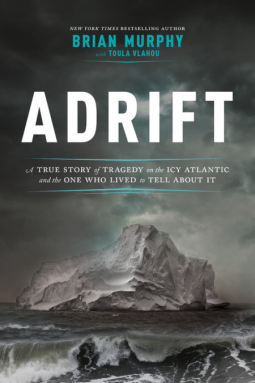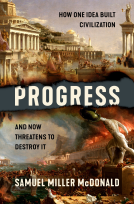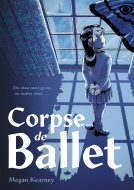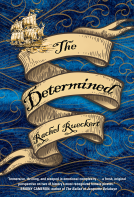
Adrift
A True Story of Tragedy on the Icy Atlantic and the One Who Lived to Tell about It
by Brian Murphy
This title was previously available on NetGalley and is now archived.
Send NetGalley books directly to your Kindle or Kindle app
1
To read on a Kindle or Kindle app, please add kindle@netgalley.com as an approved email address to receive files in your Amazon account. Click here for step-by-step instructions.
2
Also find your Kindle email address within your Amazon account, and enter it here.
Pub Date Sep 04 2018 | Archive Date Sep 04 2018
Perseus Books, Da Capo Press | Grand Central Publishing
Talking about this book? Use #Adrift #NetGalley. More hashtag tips!
Description
The small ship making the Liverpool-to-New York trip in the early months of 1856 carried mail, crates of dry goods, and more than one hundred passengers, mostly Irish emigrants. Suddenly an iceberg tore the ship asunder and five lifeboats were lowered. As four lifeboats drifted into the fog and icy water, never to be heard from again, the last boat wrenched away from the sinking ship with a few blankets, some water and biscuits, and thirteen souls. Only one would survive. This is his story.
As they started their nine days adrift more than four hundred miles off Newfoundland, the castaways--an Irish couple and their two boys, an English woman and her daughter, newlyweds from Ireland, and several crewmen, including Thomas W. Nye from Fairhaven, Massachusetts--began fighting over food and water. One by one, though, day by day, they died. Some from exposure, others from madness and panic. In the end, only Nye and the ship's log survived.
Using Nye's firsthand descriptions and later newspaper accounts, ship's logs, assorted diaries, and family archives, Brian Murphy chronicles the horrific nine days that thirteen people suffered adrift on the cold gray Atlantic. Adrift brings readers to the edge of human limits, where every frantic decision and desperate act is a potential life saver or life taker.
Available Editions
| EDITION | Other Format |
| ISBN | 9780306902000 |
| PRICE | $36.00 (USD) |
| PAGES | 288 |
Links
Average rating from 41 members
Featured Reviews
 Paul C, Educator
Paul C, Educator
Brian Murphy’s Adrift is a tale of 18th-century high-seas shipwreck and survival that is exhaustingly researched, yet told with the urgency of a good thriller. In January of 1856 the packet ship John Rutledge is scheduled to sail from Liverpool to New York City, but midway in her journey, an iceberg tears into her hull. Murphy focuses his narrative on the stories of Captain Alexander Kelley, the Hendersons, an Irish immigrant family, and sailor Thomas Nye, the lone survivor. From embarking in Liverpool to the ice piercing the ship to the days spent stranded in the lifeboats, Murphy places us with the crew and passengers every step of the way.
The author’s research covers a virtual compendium of all things nautical in the mid-1800s. Colorful details include, among other things: the history of sea-going vessels and particularly the Rutledge herself, the commerce of trans-Atlantic shipping and passenger lines, key anecdotes of prior shipwrecks, and the life of a sailor at port and out at sea. The author takes several opportunities to make comparisons to modern times to help the reader understand the setting and the ways of Victorian era life. While tangents may stray a little too far off the main narrative focus at times, Murphy always strikes a readable tone, and his digressions are interspersed in the narrative so well that you don’t even realize that you’re learning something.
Overall, Adrift is worthy of praise and deserves to be placed next to books like Philbrick’s In the Heart of the Sea, Lansing’s Endurance, and Zuckoff’s Frozen in Time. The author’s note adds credibility and transparency to the writing process. The survivor gave us a detailed account of that perilous tragedy and Murphy added research and a careful hand to craft the story in this impressive book.
Thank you to NetGalley, Perseus Books, Da Capo Press, and Mr. Murphy for the advanced copy for review.
While reading like fiction in many parts, this is a well-researched account of the sinking of the John Rutledge in 1856. Based on the first hand account of the only survivor, this was a grueling look at survival at sea. The author fleshed out the story with historical information regarding other losses at sea, and the subsequent changes made to increase ship safety. Very interesting!
 dale d, Reviewer
dale d, Reviewer
An amazing and harrowing tale of the sea and its aftermath of a lone survivor. Powerful and compelling we learn the history of this wreck and its impact not only on the survivor but on those that were left behind
 R. J. R, Reviewer
R. J. R, Reviewer
_Adrift_ is several books melded together into one masterfully crafted history. It's the story of desperate Irish families suffering the hell of travelling in "steerage" for a chance at a better life in the New World. It's the story of the packet lines competing for scheduled cargo and passenger service between Europe and America in an age when steam was rendering sail obsolete. It's the story of icebergs sinking ships in the North Atlantic long before the Titanic--a manifest and proven danger rendering that later sinking even more inexcusable. And it's the story of death and unlikely survival in horrendous conditions.
_Adrift_ is well-written and, although it sounds trite, reads like a novel. A good novel. The narrative strands are woven together professionally, and we come to know the people the author focuses on as though they were sell-rounded fictional characters, although their sources are actual documents and letters. Murphy adopts a much appreciated convention of inventing dialogue to represent what the individuals might have said, and indicating such speculation by not placing such statements in quotes.
 Librarian 226140
Librarian 226140
A true account of the sinking of a small ship by an iceberg. In one of the life boats are 13 passengers. One of them is Thomas Nye. Having to endure the freezing conditions without food or water, is a tragic ordeal. Of the 13 in the lifeboat only one survives. The freezing conditions and the terrible thirst, has led most of the people to drink sea water. Nye has warned them of the detriment. They would not listen.
Some died quietly in their sleep. Some out of delirium, due to drinking sea water. On February 29, Nye is rescued by the Germania. He is the only survivor.
4 Stars
 Laura H, Reviewer
Laura H, Reviewer
This non-fiction book was wonderfully written. The history through out this novel is spun almost like a work of fiction. I really enjoyed the authors tone of writing. It was fabulously done. The author did a great job of showing the Victorian era compared to the current era in which we live. The whole learning experience was well done in a way that wasn't boring or felt like it just rattled on. I stayed intrigued on the subject matter and actually ended up researching it after i finished reading this. The only small complaint i had was that it felt like it strayed a bit at times, however it wasn't bad enough to where i had to sit the book down or skim read. Overall 4 stars!
 Reviewer 173301
Reviewer 173301
Very good read in the vein of the Heart of the Sea! Able to portray factual events in a manner that holds interest.
 Book Trade Professional 40537
Book Trade Professional 40537
Incredible story, and one I certainly hadn't heard before. I really enjoyed the history and background of the packet ships that sailed between Liverpool and the East Coast of the United States and the trials they faced, along with the stories of the immigrant travelers and the sailors that populated the ships. Would definitely recommend as a Young Adult crossover for summer reading as well.
 susan k, Librarian
susan k, Librarian
A harrowing account of a winter sailing trip across the Atlantic in 1856, a year the North Atlantic was crowded with ice bergs and swept by many storms. Makes one very glad for the pleasant journeys that are todays norm. Will be especially interesting for Massachusetts communities along the coast and those with a whaling history
In Adrift, Brian Murphy recounts the journey of the packet ship John Rutledge from its navigation down the Mersey River to the ice fields that sank four ships in 1856. Nearly 1,000 souls died in three months, with commercial losses in the millions of dollars. The Irish immigrants and crew on board the Rutledge were all lost, save one man. This is his story.
I love a good adventure story, and if there are ships and ice involved, I'm all in. I was also interested in reading Brian Murphy's Adrift because it is about Irish immigrants, who in 1856 had scrimped and saved for their passage, hopeful they would find a better life in America. My own Irish ancestors left their homeland for England, a much shorter sea journey. But the reasons for leaving their homeland would have been the same, as well as their poverty.
The book is based on the story of Thomas Nye, a New Bedford maritime sailor who was twenty-two when he shipped on the packet ship John Rutledge out of Liverpool. The ship carried over 100 Irish passengers, bound for New York.
In 1903, just two years before his death, a journalist interviewed Nye who told the story of the sinking of the Rutledge, his nine days asea watching the other survivors succumb to the elements and dehydration, and his providential rescue.
Murphy takes us on ye's journey, recreating the events, drawing from Nye's writings, ships logs, and newspaper accounts. We are there when the ship strikes a berg and during the launching of the lifeboats. We experience Nye watching as his fellow passengers in an open board are driven to desperate measures and die until only he is left.
It is a tale of harrowing adventure, but also a study of human nature in desperate circumstances when conventional morality and social norms are washed away. There is no cannibalism involved, thankfully, for as Murphy shares, sometimes that did happen.
Reforms to improve maritime safety did not advance until the 1912 sinking of the Titanic. (Some things never change: the lives of impoverished immigrant families did not spur safety advances, but the deaths of some of the richest men in the world did.)
As climate change accelerates the calving of Greenland's ice sheet, more icebergs will clog shipping lanes. Today we have communication between ships and ship and shore, and knowledge of where the ice fields are.
Murphy is a journalist with the Washington Post and the author of three books.
I received a free ebook from the publisher through NetGalley in exchange for a fair and unbiased review.
 Ericka S, Reviewer
Ericka S, Reviewer
I highly recommend Adrift to anyone who enjoys survival tales. I’ve read many books in this genre and this one is a stand-out.
Murphy spends part of the book reviewing the major news stories of the mid-nineteenth century, including the history and economy of packet and luxury ships. This approach gave the book a well-rounded background with some substance. He also includes anecdotes, some relevant biographical information, and an overview of the situation of immigrants in Ireland. It may have seemed tangential, but the stories were relevant to the ship, the John Rutledge, and afforded the reader a clearer picture of what the passengers were facing, both at home and abroad. Murphy describes the appalling conditions aboard the John Rutledge for the immigrant passengers in steerage – the sea-sickness, the overpowering smells, the turbulent seas, the terror.
The actual ordeal of the sinking of the John Rutledge and subsequent fight for life for those who made it to lifeboats was riveting. There was only one survivor from the shipwreck, and the book follows the story of his lifeboat, in which there were originally 13 aboard, including some children. The gripping horrors that these castaways endured is heart-wrenching.
Overall, Adrift presents a fascinating perspective on the shipping industry of the 1850s and the danger aboard these ships as they navigated the icy Atlantic. Highly recommended.
Many thanks to Netgalley and Perseus Books / DeCapo Press for the advance copy in exchange for my honest review.
 Fran H, Librarian
Fran H, Librarian
While everyone knows the story of the Titanic, few know the story of the ill-fated John Rutledge.
A true story of the ship's demise and the struggle for survival on a lifeboat.
 Katherine M, Reviewer
Katherine M, Reviewer
This is the story of a small packet sailing ship, the John Rutledge, which set off across the Atlantic from Liverpool to New York in the winter of 1856. The ship, carrying cargo and Irish emigrants, struck an iceberg in the north Atlantic, and only one soul would live to tell the tale.
There are quite a few best-selling narrative non-fiction books about famous shipwrecks, such as Erik Larson’s Dead Wake, Nathaniel Philbrick’s Heart of the Sea, and numerous books about the sinking of the Titanic. These ships have become legend, and the stories have a great deal of primary information and research behind them.
In Adrift, Murphy has given us a smaller tragedy. The sinking of the John Rutledge is one of many tragic stories lost on the shoals of history, and the careful research needed to bring it back into the light should be commended. Murphy has delved into private journals, newspaper clippings, family lore, and shipping records. What is more, he has compiled this information into a gripping, narrative story.
Fans of narrative nonfiction and tales of maritime derring-do will find a lot to admire in Murphy’s careful research and close attention to detail. History buffs cannot help but rejoice when another largely unknown story is pulled from the depths of the historical record.
An advance copy of this book was provided by the publisher via NetGalley in exchange for an honest review.
 Cindy V, Media/Journalist
Cindy V, Media/Journalist
Ice in the North Atlantic in winter is normal, but when ships put into ports along the east coast of North America in 1856, those aboard reported alarming sightings. Not only were icebergs and ice slabs far more numerous and farther south than usually found, they were huge. Some were described as being wider that New York’s Central Park and taller than the clock tower of London’s Westminster Palace once these were completed. They proved equally dangerous. Between January and March, some 830 men, women, and children perished and their ships vanished. And from the four largest of these vessels, only one man survived.
The 1850s was a decade of turbulence – the Crimean War and conflicts between those favoring slavery and those who did not – and change. The heyday of sail had ebbed, giving rise to steamships that were faster and more luxurious and not dependent on the wind to propel them from one location to another. But few emigrants could afford these new vessels, so they travelled aboard wooden sailing ships to arrive at their destinations. One such vessel was the John Rutledge, a packet ship christened in Baltimore, Maryland just five years before she left Liverpool, England for New York City on 16 January 1856.
Howland & Ridgway owned the Rutledge and hired Alexander Kelley to captain the her. Although he had served on packet ships before, this was his first time in command on a transatlantic crossing. The passage to London went smoothly and among those who sailed with him were half-owner James Lawrence Ridgway, Alexander’s wife Irene, first mate Samuel Atkinson and his wife, boatswain William Ryan, and able seaman Thomas W. Nye. The last was not yet twenty-two, but came from a long line of New Bedford sailors, some of whom were well-known among the merchant trade. When it came time to return to New York, Kelley persuaded Irene to remain in Liverpool until spring, and Ridgway chose to sail home to his family aboard the Pacific, a luxury steamship that would leave later, but arrive earlier, in New York. Several new sailors joined the crew, among them John Daley from Scotland. Aside from her cargo, the Rutledge carried steerage passengers, including William Henderson and his family: a wife, two sons and two daughters (ranging in age from five to sixteen), as well as his sister and niece who was one year old.
When the Rutledge set sail, Captain Kelley was aware of the ice reports, but not having the advantage of today’s technology, the information they contained was outdated. A month later, he realized that navigating the North Atlantic would take much longer than anticipated because of the proliferation of ice and the frequent storms the ship encountered. Four days later, on the 20th of February, the packet ship hit an iceberg and began taking on water. Unable to stop the flow, everyone was ordered to abandon ship. Not everyone got off, although many did. For those in the lifeboats they hoped and prayed that another ship would soon come to their rescue.
This book is a heartrending and compelling account of shipwreck and survival. Maps, illustrations, occasional footnotes, an explanation of types of vessels, a family tree, bibliography, and index further enhance the reading experience. Murphy, a journalist for The Washington Post, pieced together the story of what happened and the people involved from family archives, civil and church documents, shipping ledgers, interviews, and published material found in collections in Europe and the United States. Much of the dialogue is skillfully imagined –fully explained in his introduction – and, when combined with the personal histories and period details, vividly recreates life and sailing in the middle of the 19th century. His primary purpose is to tell the story of one ship and the people aboard her, yet a secondary goal is for the book to serve as an elegy to all the forgotten men, women, and children who lost their lives. He accomplishes both with dignity and passion. Adrift is so riveting that even in the midst of summer heat, the wintry cold seeps so deeply into your bones that not even the warmest wool will dispel the bleak aloneness of being surrounded by water and ice in a small boat where the only other occupants are the dead.
 Faye D, Media/Journalist
Faye D, Media/Journalist
Here’s a true story about the sinking of a much smaller ship than the Titanic that occurred in 1856. The ship carried mail and supplies as well as around 100 Irish immigrants heading to the United States.
They managed to lower five lifeboats. Four drifted away and were never found. The fifth, containing 13 people, a couple of blankets and a tiny amount of food and water, spent nine days adrift more than 400 miles off Newfoundland.
Thomas W. Nye, a crewman from Fairhaven, Mass., had the sea in his veins. Many of his ancestors had been ship captains. He, along with an Irish couple and their sons, an English woman and her daughter, a newlywed couple and other crew members, made up the little group of castaways. During the ordeal, some died from the cold, others from panic or drinking ocean water. Nye, along with the ship’s log he had saved before boarding the lifeboat, was found.
This fascinating book is based on his firsthand descriptions, newspaper accounts, ship’s logs, diaries and family archives.
This tragedy serves to make clear that the decisions made during a catastrophe like this definitely are life and death.
 Bonnye Reed F, Reviewer
Bonnye Reed F, Reviewer
Brian Murphy brings us not just the history of the last sailing of the John Rutledge, a packet ship out of New England, but details of the horrendous weather and many loses felt that winter of 1856. From the first of January until the end of March, nearly 830 passengers and crew were lost if just four of the lost ships making their way from Europe to the U.S.
The mid-nineteenth century is a period of our human history that I love. And I do what research I can before I ask for a book from Netgalley or Goodreads, picking books I really want to read. Adrift was one of those intriguing books with a few five star reviews on Goodreads, and a couple of one or two stars. I loved this story for the very reason those one or two star reviewers didn't - Brian Murphy researched this time in history, the problems and perks involved in the seafaring life at that time, and this year of monstrous weather that cost so much in in lives and ships and goods. He shares all of that incredible research with us. This was a book I read cover to cover without a break, and one I will keep in my research shelf. These are facts I will want to visit again.
I received a free electronic copy of this history of the January 16th, 1856 sailing of the John Rutledge packet ship carrying one cabin passenger, a full measure of officers and crew and over a hundred and twenty, mostly Irish, immigrants in steerage from the River Mersey in Liverpool to New York from Netgalley, Brian Murphy, and Perseus Books, Da Capo Press in exchange for an honest review. Thank you all for sharing your hard work with me.
 Robyn H, Reviewer
Robyn H, Reviewer
Adrift is a distressing story about loss and survival in the Atlantic. Adrift recounts the story of Thomas W. Nye after the passenger ship he was on capsized. This tale focused on his fight to survive on a raft with thirteen others. This book was packed with both history and action. I found myself falling into the story, desperate to discover what happened next. If you love stories about survival in harsh elements then you will enjoy this book!
The timeline of events was well established and I found the information on the ship and iceberg activity the year of the tragedy to be very explanatory. This was one of my favorite survival tales to date. I really enjoyed this story and my heart broke for those lost to the ocean. Adrift was released today, September 4th. I received this ARC from NetGalley in exchange for an honest review.
An outstanding tale of tragedy and salvation at sea.
In Adrift, Murphy gives us a riveting account of the tragic fate of the packet ship John Rutledge during a harrowing Atlantic crossing in 1856. The book is rife with sociocontextual detail and reads beautifully, about as close to prose as nonfiction can get.
The shipwreck itself will keep readers on the edge of their proverbial seats, though it's the time recounted in the lifeboat where the story really hits its stride. The scene is at once atmospherically eerie to the point of almost feeling surreal and also brutally raw.
The "Lifeboat as Moral Dilemma" is always a fascinating topic, and this iteration doesn't disappoint. It actually comes off as more gripping that almost every fictional account I've read of a similar situation.
Beautifully, intensely written from start to finish, Adrift is that rare nonfiction offering that never drags (even for a paragraph). For added atmosphere, I recommend listening to the Pirates of the Caribbean: Curse of the Black Pearl score while reading.
 Sarah Corbett M, Reviewer
Sarah Corbett M, Reviewer
The John Rutledge, a three-master out of Liverpool and bound for America in 1856, hits an iceberg in the North Atlantic and goes down. Although there were several lifeboats full of passengers, there was only one survivor, Thomas Nye. Authors Murphy and Vlahou, use Nye's notes, newspaper articles from the time, and historical records to recreate the story as it might have unfolded. They create a rich account of the life of Irish immigrants, mid-nineteenth century sailing, as well as the harrowing tale of Nye's survival. Plenty of sailing history for maritime buffs.
 Julie W, Reviewer
Julie W, Reviewer
January, 1856. Captain Alexander Kelley is sailing the packet ship John Rutledge from Liverpool to New York, completing his first transatlantic voyage as a captain. He leaves his wife behind in Liverpool as the voyage will be rough given the time of year, and promises to pick her up in the spring when they can return to New York together. It is a promise he will break. After 35 days at sea on February 20th, 1856, The John Rutledge struck an iceberg in the Atlantic and sank. 13 survivors boarded life boats. Nine days later, the only survivors were one crew member and the ship's log book.
A disaster tale such as this one is even more emotional when it's a true story. Murphy weaves the story of the fate of the John Rutledge with great skill. It chilled me to the bone thinking about the few survivors floating in open boats in the freezing cold elements, only to die. And the many emigrants from Ireland -- men, women and children seeking a better life -- who never made it off the ship. I had to watch two Disney movies after I finished this book to get the sad, emotional thoughts out of my head. Those poor people....and what a horrible, lonely way to die.
In his introduction to the book, the author says: Scores of ships -- carrying tens of thousands of passengers and crew -- met a similar fate in the Atlantic before twentieth-century advances in communications technology enabled better advance notice on looming ice fields and approaching storms. The names of some lost ships are remembered. So are a few of the prominent figures that perished at sea. But almost totally forgotten are the others who went down with them: emigrants, seamen, travelers, merchants and envoys. Entire families. Young men and women striking out for a new life. Children too young to grasp the dangers of an Atlantic crossing. They are the anonymous dead. The sea is good at swallowing lives without a trace. It happened that way for so many.....dreams of a new life over so quickly...and now nobody even remembers their names or anything about them. I thought about each and every one of them as I read this book.
A book that can elicit a profound emotional response in a reader is well written. This book sucked me into the story of this doomed ship and kept my total attention from start to finish. I felt an emotional tie to the people I knew were going to die. Brian Murphy is a skilled story-teller. Excellent book. Heart-breaking story. Anyone who enjoys adventure stories, historical tales or the sea will love this book. It's hard to read -- the outcome is bleak. But I'm glad a skilled writer told their story. Those who crossed the ocean before the age of modern communications and safety precautions were taking a huge risk. So many were lost. I'm glad that some are still remembered.
I have a son in the Navy and even though I am not really a religious person, I thought of this naval hymn while reading this story:
For Those In Peril On The Sea
Eternal Father, strong to save,
Whose arm doth bind the restless wave,
Who bidd’st the mighty ocean deep
Its own appointed limits keep;
O hear us when we cry to Thee,
For those in peril on the sea!
O Saviour, Whose almighty word
The winds and waves submissive heard,
Who walkedst on the foaming deep,
And calm amid its rage didst sleep:
O hear us when we cry to Thee
For those in peril on the sea!
O Sacred Spirit, who didst brood
Upon the chaos dark and rude,
Who bad’st its angry tumult cease,
And gavest light, and life, and peace:
O hear us when we cry to Thee
For those in peril on the sea!
O Trinity of love and power,
Our brethren shield in danger’s hour;
From rock and tempest, fire and foe,
Protect them wheresoe’er they go;
And ever let there rise to Thee
Glad hymns of praise from land and sea.
**I voluntarily read a review copy of this book from Perseus Books/DeCapo Press via NetGalley. All opinions expressed are entirely my own.**
Readers who liked this book also liked:
Jennie Batchelor, Julia Quinn, Natalie Jenner, Charlie Lovett, Talulah Riley, Janet Todd et al
Essays & Collections, Novellas & Short Stories, Women's Fiction


















